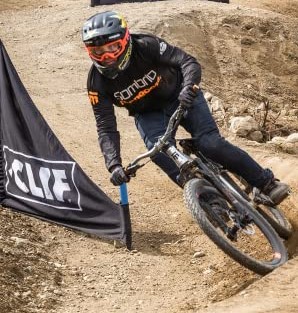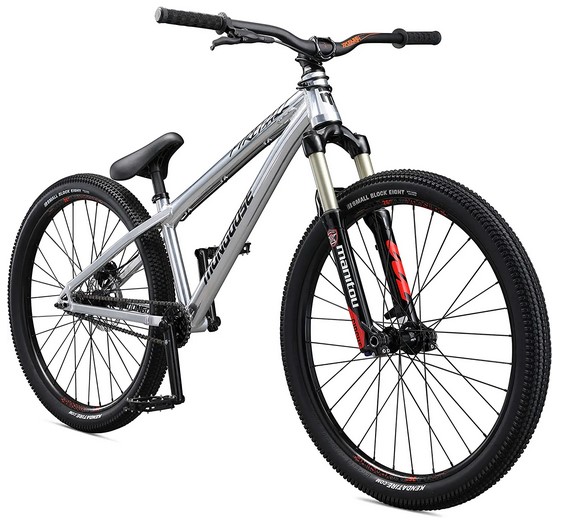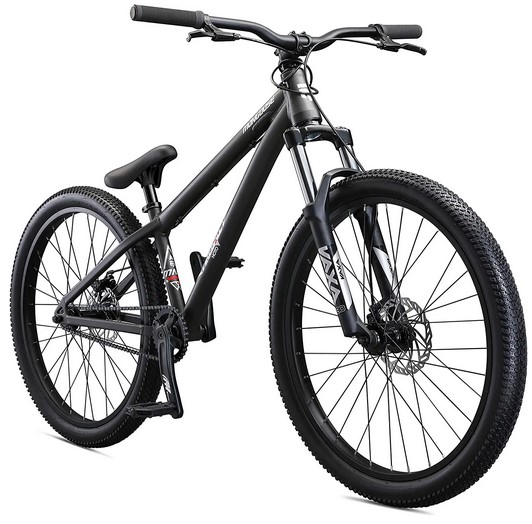Dirt jumpers are less popular because they are tinnier than standard bicycles. Therefore, sizing them becomes tricky, so if you are interested in having one, you are likely asking, what size dirt jumper should I get?
If you are 5’7”-6’1” tall, then a medium-sized dirt jumper with a 558-584mm effective top tube and a reach of 400-410mm suits you. Generally, taller riders require bigger frames with a longer top tube and a longer reach, and vice versa is true for shorter cyclists.
The post simplifies the selection process by outlining the factors to consider should you size a dirt jumper.

What Size Dirt Jumper Should I Get? (Factors Influencing Dirt Jumper Sizing)
In general, the factors listed below can help you figure out what size jumper is best for you.
1. The Reach Vs. Dirt Jumper Size- The Contact Points
The pedals and handlebars are your primary points of contact when riding a BMX or a dirt jumper. As a result, the distance between the head tube and the bottom bracket affects how small or big a frame appears.
There are two methods for calculating that distance: the downtube length or the frame reach.
The reach (also known as cockpit room) is the horizontal distance between the middle of the head tube and the center of the bottom bracket. It comes in handy in determining a dirt jumper size because it describes the distance between two points of contact
Additionally, the reach guides you in identifying the appropriate bike frame size for your height.
Dirt jumper bike companies such as Transition, Norco, and Canyon outline their dirt jumpers’ reach to make sizing easier. However, other companies do not do so, thus tasking you to physically determine the distance, which can be difficult when shopping online.
If the length of the reach is not specified, you can contact the seller or the manufacturer.
Canyon comes in two different sizes: small and large. The small model features a 400mm reach hence suitable for people standing 140-170cm tall.
Its large counterpart constitutes a 417mm reach, recommended for cyclists between 160cm and 200cm in height.
The transition has two sizes: large and X-large, whereas Norco has three models: small, medium, and large.
See the table below.
| Dirt Jump Brand | Reach (mm) | Frame Size | Rider’s Height |
| Canyon | 400mm | Small | 4’7”-5’7” (140-170 cm) |
| 417mm | Large | 5’3”-6’7” (160-200 cm) | |
| Norco | 415mm | Small | 4’7-5’7” (140-170 cm) |
| 405mm | Medium | 5’7”-6’1” (170-185 cm) | |
| 430mm | Large | 6’1”+ (185 cm +) | |
| Transition | 440mm | Large | 5’7-6’1” (170-185 cm) |
| 465mm | X-Large | 6’1” + (185 cm +) |
The table clearly shows that the size of the frame varies depending on the brand. A dirt jumper listed as small in one brand could be medium or large for another one.
As you can see, a small Canyon frame nearly matches a medium Norco frame. On the other hand, a large Canyon frame is almost equivalent to a small Transition frame.
As a result, it is essential to review the technical information provided by the manufacturer before making a purchase.
Once you have determined the proper bike reach and matched it with the appropriate frame size and height, you can identify the perfect bike size. Alternatively, you can ascertain the top tube length of the bike as described below.
2. Dirt Jumper Size Vs. Top Tube Length
The size of most dirt jumpers’ frames is frequently classified based on the top tube length. Some dirt jumper brands list their bikes’ top tube lengths to help you buy the right-sized bike frame.
You should note the difference between the effective top tube and the actual top tube.
The effective top tube is usually longer than the actual top tube. Generally, it is the distance separating the seat tube from the head tube.
Instead of providing the actual top tube length, most manufacturers list measurements of their effective top tubes. The values, like the reach, vary depending on the manufacturer.
The table below will help you match the top tube length of your bike to the frame size and height.
| Effective Tube Length | Frame Size | Cyclist’s Height |
| 21.5-22” (546-558 cm) | Small | 4’7-5’7” (140-170 cm) |
| 22-23” (558-584 cm) | Medium | 5’7”-6’1” (170-185 cm) |
| 23”+ (584 cm +) | Large | 6’1” + (185 cm +) |
3. The Reach Vs. Top Tube Length: What Should I Choose?
Although the length of the top tube determines frame size, it is not as precise as the reach. Because the angle of the seat tube varies from company to company, the top tube length differs as well.
In contrast, the seat tube angle does not affect the reach.
Two frames with the same reach can sport top tube lengths that are not identical.
4. The Seat Tube Length is Irrelevant
Most cyclists use the center-to-top approach when configuring a traditional bicycle (for example, a road bike). They measure the distance between the upper end of the seat tube and the center of the bottom bracket.
Nevertheless, this might not work when categorizing a BMX or a dirt jumper because cyclists ride stunt bikes while standing.
Cyclists do not use the seat posts as contact points while riding, which implies the top tube length is not the most significant element. The saddle on BMX bikes and dirt jumpers rests between jumps and tricks.
What Size Dirt Jump Do I Need? (Helpful Tips)
Knowing what to consider when picking your dirt jumper, it is time to choose one.
1. Most Dirt Jumpers Come In One Size
Not every brand provides a variety of sizes. Several dirt jumpers are available in a single size intended to accommodate most cyclists of average height. When a design is only available in one size, it typically has a reach of 400mm and an effective top tube length of 600mm.
Mongoose is an excellent example of a bike brand that offers dirt jumpers in a single size. Its mainstream dirt jumper bike line, the Mongoose Fireball, is only available in one size, which fits riders with heights between 5’4” to 6’2”.
For instance, the Mongoose Fireball Dirt Jump Mountain Bike (View on Amazon) fits 5’4” to 6’2” riders. It has 26-inch wheels, a front suspension, and an aluminum, lightweight frame.

Dirt jumpers come in single-speed configurations with low seats because they are neither trail nor commuter bikes.
This aspect, combined with dirt jumpers’ small market share, dampens the motivation to produce a wide range of dirt jumpers.
2. The Stem and Handlebar are Adjustable
A frame size matching your height does not necessarily guarantee the bike will suit you perfectly. Likewise, a small frame does not rule out the possibility of a dirt jumper matching you.
The stem length is also crucial. A longer stem extends the reach, while its shorter counterpart does the opposite.
Most dirt jump bicycles have shorter stems because they improve handling and bring stability. However, shorter stems are not flawless in that they render climbing difficult by cutting down weight on front tires.
On the flip side, dirt jumpers are not equipped for climbing, thus making shorter stems the best option.
The stems of dirt jumpers range between 30 and 50mm in length, and you can constantly adjust the stem and handlebars of the bike to match your height. Tall cyclists take advantage of the handlebars with a higher elevation to raise the bike height and keep them from unnecessary bending.
3. Many Cyclists Ride Smaller Frames On Purpose
Scores of cyclists that are tall enough to ride bigger models prefer smaller frames because they are lightweight and easier to control.
a) The Riding Style Matters
Because of the added stability, larger frames coupled with a longer wheelbase are better suited for jumping. For more specialized biking, frames with shorter chainstays are the routine.
Despite the guidelines, personal preference takes precedence in this case.
b) The Rider’s Anthropometry
When it comes to sizing a dirt jumper, both the height and individual proportions (anthropometry) come to play. A chart may recommend a specific bike for your height, only for you to be uncomfortable on it.
It could be because your arms or legs are longer or shorter than expected. Consequently, test riding a bike before buying it will do you a lot of good.

FAQs
1. How Do You Size A Dirt Jumper?
Most experts size dirt jump bikes by determining the distance between the middle of the head tube and the middle of the seat tube. Taller cyclists will most probably prefer longer tube lengths.
2. What Size Should My Dirt Jumper Be?
A dirt jumper with a 570mm-600mm/22.5′′-23.5′′ effective top tube and a 400mm/15.74′′ reach is a perfect fit for an average height adult. Shorter adults can consider frames with an effective top tube measuring 550mm/21.5′′.
3. Why Are Dirt Jumpers So Expensive?
Dirt jumpers are pricey because they fill a small biking niche owing to their high specialization.
As a result, there are fewer manufacturers, which translates to less competition and lower manufacturing volume. The brands charge a higher price to cushion the effects of low demand and cover their costs.
4. Does Dirt Jumper Size Matter?
A cyclist with an average height between 5’7”-6’1” needs a medium-sized dirt jumper with an effective top tube length of 558-584mm and a 400-410mm reach. Taller cyclists need massive frames with a longer top tube length and reach.
5. Why Should I Buy A Dirt Jumper?
You should get a dirt jumper since it is more robust wheels and frames than cross-country MTBs, making them ideal for absorbing shocks from tricks and high jumps. In addition, dirt jumpers feature a distinct geometry that allows them to transition safely and smoothly from the ground to the air.
6. What Is A Good Weight For A Dirt Jumper?
A dirt jumper hardtail that has a suspension fork weighs between 30-32 pounds on average. However, the front brake, coil forks or air, Aluminum or CrMo, build, amongst others, would affect the weight.
In Conclusion, What Size Dirt Jumper Should I get?
To ascertain your perfect bike size, you must consider the bike’s effective top tube, the reach, or both. You can use the sizing chart provided in the post to find your perfect fit.
Also Read:
